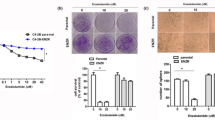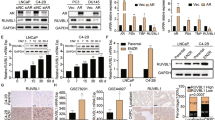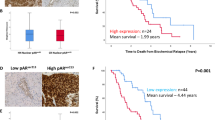Abstract
The type 1 insulin-like growth factor receptor (IGF1R) is overexpressed in prostate cancer, and mediates proliferation, motility, and survival. Many prostate cancers harbor inactivating PTEN mutations, enhancing Akt phosphorylation. This activates the principal antiapoptotic pathway downstream of the IGF1R, calling into question the value of IGF1R targeting in this tumor. The aim of the current study was to assess the effect of IGF1R gene silencing in prostate cancer cells that lack functional PTEN protein. In human DU145, LNCaP and PC3 prostate cancer cells, transfection with IGF1R small interfering RNA induced significant enhancement of apoptosis and inhibition of survival, not only in PTEN wild-type DU145 but also in PTEN mutant LNCaP and PC3. This was attributed to attenuation of IGF signaling via Akt, ERKs and p38. In both DU145 and PC3, IGF1R knockdown led to enhancement of sensitivity to mitoxantrone, etoposide, nitrogen mustard and ionizing radiation. There was no sensitization to paclitaxel or 5-fluorouracil, which do not damage DNA, suggesting that chemosensitization results from impairment of the DNA damage response, in addition to removal of apoptosis protection. These results support the concept of IGF1R targeting in prostate cancer, and indicate that PTEN loss does not render tumor cells refractory to this strategy.
This is a preview of subscription content, access via your institution
Access options
Subscribe to this journal
Receive 12 print issues and online access
$259.00 per year
only $21.58 per issue
Buy this article
- Purchase on Springer Link
- Instant access to full article PDF
Prices may be subject to local taxes which are calculated during checkout







Similar content being viewed by others
References
Parker SL, Tong T, Bolden S, Wingo PA . Cancer statistics, 1997. CA Cancer J Clin. 1997; 47: 5–27.
Byrne RL, Leung H, Neal DE . Peptide growth factors in the prostate as mediators of stromal epithelial interaction. Br J Urol. 1996; 77: 627–633.
Oh WK, Kantoff PW . Management of hormone refractory prostate cancer: current standards and future prospects. J Urol. 1998; 160: 1220–1229.
Wang J, Halford S, Rigg A, Roylance R, Lynch M, Waxman J . Adjuvant mitozantrone chemotherapy in advanced prostate cancer. BJU Int. 2000; 86: 675–680.
Kish JA, Bukkapatnam R, Palazzo F . The treatment challenge of hormone-refractory prostate cancer. Cancer Control. 2001; 8: 487–495.
Chan JM, Stampfer MJ, Giovannucci E, et al. Plasma insulin-like growth factor-I and prostate cancer risk: a prospective study. Science. 1998; 279: 563–566.
Wolk A, Mantzoros CS, Andersson SO, et al. Insulin-like growth factor 1 and prostate cancer risk: a population-based, case–control study. J Natl Cancer Inst. 1998; 90: 911–915.
Baserga R . The IGF-I receptor in cancer research. Exp Cell Res. 1999; 253: 1–6.
Bohula EA, Playford MP, Macaulay VM . Targeting the type 1 insulin-like growth factor receptor as anti-cancer treatment. Anticancer Drugs. 2003; 14: 669–682.
Maile LA, Imai Y, Clarke JB, Clemmons DR . Insulin-like growth factor I increases alpha V beta 3 affinity by increasing the amount of integrin-associated protein that is associated with non-raft domains of the cellular membrane. J Biol Chem. 2002; 277: 1800–1805.
Jackson JG, Zhang X, Yoneda T, Yee D . Regulation of breast cancer cell motility by insulin receptor substrate-2 (IRS-2) in metastatic variants of human breast cancer cell lines. Oncogene. 2001; 20: 7318–7325.
Playford MP, Bicknell D, Bodmer WF, Macaulay VM . Insulin-like growth factor 1 regulates the location, stability, and transcriptional activity of beta-catenin. Proc Natl Acad Sci USA. 2000; 97: 12103–12108.
Grzmil M, Hemmerlein B, Thelen P, Schweyer S, Burfeind P . Blockade of the type I IGF receptor expression in human prostate cancer cells inhibits proliferation and invasion, up-regulates IGF binding protein-3, and suppresses MMP-2 expression. J Pathol. 2004; 202: 50–59.
Kurek R, Tunn UW, Aumueller G, Renneberg H . Insulin-like growth factor-1 (IGF-1) and insulin-like growth factor receptor (IGFR-1) in prostate cancer. J Urol. 2000; 163(Suppl): 35.
Hellawell GO, Turner GD, Davies DR, Poulsom R, Brewster SF, Macaulay VM . Expression of the type 1 insulin-like growth factor receptor is up-regulated in primary prostate cancer and commonly persists in metastatic disease. Cancer Res. 2002; 62: 2942–2950.
Nickerson T, Chang F, Lorimer D, Smeekens SP, Sawyers CL, Pollak M . In vivo progression of LAPC-9 and LNCaP prostate cancer models to androgen independence is associated with increased expression of insulin-like growth factor I (IGF-I) and IGF-I receptor (IGF-IR). Cancer Res. 2001; 61: 6276–6280.
Burfeind P, Chernicky CL, Rininsland F, Ilan J . Antisense RNA to the type I insulin-like growth factor receptor suppresses tumor growth, prevents invasion by rat prostate cancer cells in vivo. Proc Natl Acad Sci USA. 1996; 93: 7263–7268.
McMenamin ME, Soung P, Perera S, Kaplan I, Loda M, Sellers WR . Loss of PTEN expression in paraffin-embedded primary prostate cancer correlates with high Gleason score and advanced stage. Cancer Res. 1999; 59: 4291–4296.
Wang S, Gao J, Lei Q, et al. Prostate-specific deletion of the murine Pten tumor suppressor gene leads to metastatic prostate cancer. Cancer Cell. 2003; 4: 209–221.
Davies MA, Koul D, Dhesi H, et al. Regulation of Akt/PKB activity, cellular growth, and apoptosis in prostate carcinoma cells by MMAC/PTEN. Cancer Res. 1999; 59: 2551–2556.
Reiss K, Wang JY, Romano G, et al. IGF-I receptor signaling in a prostatic cancer cell line with a PTEN mutation. Oncogene. 2000; 19: 2687–2694.
Hellawell GO, Ferguson DJ, Brewster SF, Macaulay VM . Chemosensitization of human prostate cancer using antisense agents targeting the type 1 insulin-like growth factor receptor. BJU Int. 2003; 91: 271–277.
Bohula EA, Salisbury AJ, Sohail M, et al. The efficacy of small interfering RNAs targeted to the type 1 insulin-like growth factor receptor (IGF1R) is influenced by secondary structure in the IGF1R transcript. J Biol Chem. 2003; 278: 15991–15997.
Elbashir SM, Harborth J, Lendeckel W, Yalcin A, Weber K, Tuschl T . Duplexes of 21-nucleotide RNAs mediate RNA interference in cultured mammalian cells. Nature. 2001; 411: 494–498.
Macaulay VM, Salisbury AJ, Bohula EA, Playford MP, Smorodinsky NI, Shiloh Y . Downregulation of the type 1 insulin-like growth factor receptor in mouse melanoma cells is associated with enhanced radiosensitivity and impaired activation of Atm kinase. Oncogene. 2001; 20: 4029–4040.
Trojanek J, Ho T, Del Valle L, et al. Role of the insulin-like growth factor I/insulin receptor substrate 1 axis in Rad51 trafficking and DNA repair by homologous recombination. Mol Cell Biol. 2003; 23: 7510–7524.
Elbashir SM, Martinez J, Patkaniowska A, Lendeckel W, Tuschl T . Functional anatomy of siRNAs for mediating efficient RNAi in Drosophila melanogaster embryo lysate. EMBO J. 2001; 20: 6877–6888.
Ullrich A, Gray A, Tam AW, et al. Insulin-like growth factor I receptor primary structure: comparison with insulin receptor suggests structural determinants that define functional specificity. EMBO J. 1986; 5: 2503–2512.
Hemminki K, Alhonen A, Linkola E, Hesso A . Kinetics of hydrolysis in vitro of nornitrogen mustard, a metabolite of phosphoramide mustard and cyclophosphamide. Arch Toxicol. 1987; 61: 126–130.
Iwamura M, Sluss PM, Casamento JB, Cockett AT . Insulin-like growth factor I: action and receptor characterization in human prostate cancer cell lines. Prostate. 1993; 22: 243–252.
Zhao H, Dupont J, Yakar S, Karas M, LeRoith D . PTEN inhibits cell proliferation and induces apoptosis by downregulating cell surface IGF-IR expression in prostate cancer cells. Oncogene. 2004; 23: 786–794.
Wu Y, Karas M, Dupont J, Zhao H, Toyoshima Y, Le Roith D . Multiple signaling pathways are involved in the regulation of IGF-I receptor inhibition of PTEN-enhanced apoptosis. Growth Horm IGF Res. 2004; 14: 52–58.
Saxena S, Jonsson ZO, Dutta A . Small RNAs with imperfect match to endogenous mRNA repress translation. Implications for off-target activity of small inhibitory RNA in mammalian cells. J Biol Chem. 2003; 278: 44312–44319.
Peruzzi F, Prisco M, Dews M, et al. Multiple signaling pathways of the insulin-like growth factor 1 receptor in protection from apoptosis. Mol Cell Biol. 1999; 19: 7203–7215.
Kimura G, Kasuya J, Giannini S, et al. Insulin-like growth factor (IGF) system components in human prostatic cancer cell-lines: LNCaP, DU145, and PC-3 cells. Int J Urol. 1996; 3: 39–46.
Torring N, Jorgensen PE, Sorensen BS, Nexo E . Increased expression of heparin binding EGF (HB-EGF), amphiregulin, TGF alpha and epiregulin in androgen-independent prostate cancer cell lines. Anticancer Res. 2000; 20: 91–95.
Crowe DL, Ohannessian A . Recruitment of focal adhesion kinase and paxillin to beta1 integrin promotes cancer cell migration via mitogen activated protein kinase activation. BMC Cancer. 2004; 4: 18.
Levy Y, Ronen D, Bershadsky AD, Zick Y . Sustained induction of ERK, protein kinase B, and p70 S6 kinase regulates cell spreading and formation of F-actin microspikes upon ligation of integrins by galectin-8, a mammalian lectin. J Biol Chem. 2003; 278: 14533–14542.
Guan KL, Figueroa C, Brtva TR, et al. Negative regulation of the serine/threonine kinase B-Raf by Akt. J Biol Chem. 2000; 275: 27354–27359.
Zimmermann S, Moelling K . Phosphorylation and regulation of Raf by Akt (protein kinase B). Science. 1999; 286: 1741–1744.
Xiao D, Singh SV . Phenethyl isothiocyanate-induced apoptosis in p53-deficient PC-3 human prostate cancer cell line is mediated by extracellular signal-regulated kinases. Cancer Res. 2002; 62: 3615–3619.
Parrizas M, Saltiel AR, LeRoith D . Insulin-like growth factor 1 inhibits apoptosis using the phosphatidyinositol 3′-kinase and mitogen-activated protein kinase pathways. J Biol Chem. 1997; 272: 154–161.
Walsh PT, Smith LM, O'Connor R . Insulin-like growth factor-1 activates Akt and Jun N-terminal kinases (JNKs) in promoting the survival of T lymphocytes. Immunology. 2002; 107: 461–471.
Dunn SE, Hardman RA, Kari FW, Barrett JC . Insulin-like-growth-factor-1 (IGF-1) alters drug-sensitivity of HBL100 human breast-cancer cells by inhibition of apoptosis induced by diverse anticancer drugs. Cancer Res. 1997; 57: 2687–2693.
Geier A, Weiss C, Beery R, et al. Multiple pathways are involved in protection of MCF-7 cells against death due to protein synthesis inhibition. J Cell Physiol. 1995; 163: 570–576.
Gooch JL, Van Den Berg CL, Yee D . Insulin-like growth factor (IGF)-I rescues breast cancer cells from chemotherapy-induced cell death--proliferative and anti-apoptotic effects. Breast Cancer Res Treat. 1999; 56: 1–10.
Sell C, Baserga R, Rubin R . Insulin-like growth factor I (IGF-I) and the IGF-I receptor prevent etoposide-induced apoptosis. Cancer Res. 1995; 55: 303–306.
Sessa C . Anticancer agents. In: Cavalli FH, Kaye HH, Stanley B, eds. Textbook of Medical Oncology. London: Martin Dunitz Ltd; 1997.
Shiloh Y . ATM and related protein kinases: safeguarding genome integrity. Nat Rev Cancer. 2003; 3: 155–168.
Kasibhatla S, Tseng B . Why target apoptosis in cancer treatment? Mol Cancer Ther. 2003; 2: 573–580.
Valerie K, Povirk LF . Regulation and mechanisms of mammalian double-strand break repair. Oncogene. 2003; 22: 5792–5812.
McHugh PJ, Spanswick VJ, Hartley JA . Repair of DNA interstrand crosslinks: molecular mechanisms and clinical relevance. Lancet Oncol. 2001; 2: 483–490.
Eisenberger MA, De Wit R, Berry W, et al. 2004 ASCO Annual Meeting Abstract 4. New Orleans; 2004.
Horowitz RW, Heerdt BG, Hu X, Schwartz EL, Wadler S . Combination therapy with 5-fluorouracil and IFN-alpha2a induces a nonrandom increase in DNA fragments of less than 3 megabases in HT29 colon carcinoma cells. Clin Cancer Res. 1997; 3: 1317–1322.
Sun HZ, Wu SF, Tu ZH . Blockage of IGF-1R signaling sensitizes urinary bladder cancer cells to mitomycin-mediated cytotoxicity. Cell Res. 2001; 11: 107–115.
Scotlandi K, Avnet S, Benini S, et al. Expression of an IGF-I receptor dominant negative mutant induces apoptosis, inhibits tumorigenesis and enhances chemosensitivity in Ewing's sarcoma cells. Int J Cancer. 2002; 101: 11–16.
Scotlandi K, Maini C, Manara MC, et al. Effectiveness of insulin-like growth factor I receptor antisense strategy against Ewing's sarcoma cells. Cancer Gene Ther. 2002; 9: 296–307.
Benini S, Manara MC, Baldini N, et al. Inhibition of insulin-like growth factor I receptor increases the antitumor activity of doxorubicin and vincristine against Ewing's sarcoma cells. Clin Cancer Res. 2001; 7: 1790–1797.
Paulussen M, Frohlich B, Jurgens H . Ewing tumour: incidence, prognosis and treatment options. Paediatr Drugs. 2001; 3: 899–913.
Min Y, Adachi Y, Yamamoto H, et al. Genetic blockade of the insulin-like growth factor-I receptor: a promising strategy for human pancreatic cancer. Cancer Res. 2003; 63: 6432–6441.
Acknowledgements
This work was supported by Cancer Research UK and by a Health Foundation Fellowship to MR. We are grateful to Ian Hickson, Peter McHugh, and Andrew Protheroe for comments on the manuscript.
Author information
Authors and Affiliations
Corresponding author
Rights and permissions
About this article
Cite this article
Rochester, M., Riedemann, J., Hellawell, G. et al. Silencing of the IGF1R gene enhances sensitivity to DNA-damaging agents in both PTEN wild-type and mutant human prostate cancer. Cancer Gene Ther 12, 90–100 (2005). https://doi.org/10.1038/sj.cgt.7700775
Received:
Published:
Issue Date:
DOI: https://doi.org/10.1038/sj.cgt.7700775
Keywords
This article is cited by
-
CHK1 inhibition exacerbates replication stress induced by IGF blockade
Oncogene (2022)
-
The tRNA-derived fragment 5026a inhibits the proliferation of gastric cancer cells by regulating the PTEN/PI3K/AKT signaling pathway
Stem Cell Research & Therapy (2021)
-
Immune targeting of autocrine IGF2 hampers rhabdomyosarcoma growth and metastasis
BMC Cancer (2019)
-
Insulin-Like Growth Factor (IGF) Pathway Targeting in Cancer: Role of the IGF Axis and Opportunities for Future Combination Studies
Targeted Oncology (2017)
-
Key regulators in prostate cancer identified by co-expression module analysis
BMC Genomics (2014)



